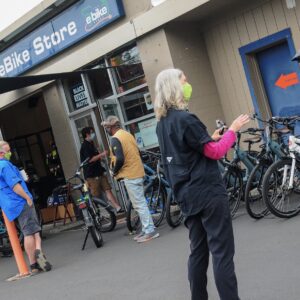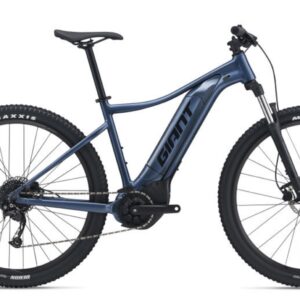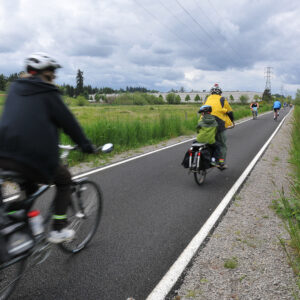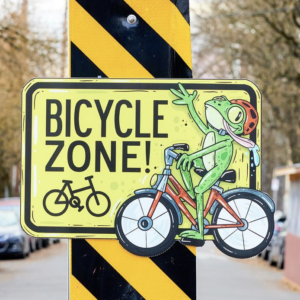
(Photo: Jonathan Maus/BikePortland)
A grant program from Portland General Electric will fund the purchase of electric bikes for two local organizations and help subsidize access to the Biketown bike share system. The PGE Drive Change Fund announced $2.3 million in awards today and among the 12 winners were the Community Cycling Center, the Portland State University Bike Hub, and the City of Portland Bureau of Transportation.
Here’s the official blurb on each award:
Advertisement
Community Cycling Center, Portland – $50,000
…CCC will use this funding to purchase four e-bicycles that will help expand the reach of programs while also decreasing car travel for internal needs. Initially, the bikes will support a COVID response food pantry delivery by bike program, and in the long term will support educational and community events and outreach and general internal trips between the shops and warehouses. CCC will also use this funding to train their mechanics to maintain the e-bikes, which would also expand their capacity to provide e-bike service to customers.Portland Bureau of Transportation, Portland – $130,000
… BIKETOWN will grow to 3,000 e-bikes with a larger service area by 2024. BIKETOWN has two equity programs: Adaptive BIKETOWN provides bicycle access for people with disabilities; and BIKETOWN for All provides discounted memberships and fares for people living on low incomes. PBOT will use the PGE Drive Change grant to further reduce financial barriers, providing free ride credits for an average year of BIKETOWN use. The Drive Change funds will also provide discounts for young riders – BIKETOWN recently lowered the minimum rider age to 16 to introduce more teens to the benefits of bike sharing.Portland State University, Portland – $36,000
The Portland State University (PSU) Bike Hub is a full-service retail bike shop on campus, opened in 2010. The shop offers long term bike rental through its “Vike Bike” program, a fleet of over 140 bikes offered at low cost (or no cost based on need). The program’s existing fleet was assembled by collecting and refurbishing abandoned bikes on campus and made available to students for long-term rentals. PSU will use this funding to purchase 25 Batch Bicycles e-bikes, to supplement the rental fleet and provide greater access to those living further from campus or those with physical barriers to cycling, and serve as a pilot program toward the eventual full replacement of the rental fleet with e-bikes.
— Jonathan Maus: (503) 706-8804, @jonathan_maus on Twitter and jonathan@bikeportland.org
— Get our headlines delivered to your inbox.
— Support this independent community media outlet with a one-time contribution or monthly subscription.






Thanks for reading.
BikePortland has served this community with independent community journalism since 2005. We rely on subscriptions from readers like you to survive. Your financial support is vital in keeping this valuable resource alive and well.
Please subscribe today to strengthen and expand our work.
A better more direct link to the award recipient list for 2020/21: https://portlandgeneral.com/news/2021-01-27-pge-drive-change-fund-awards-usd2-3-million-to-local
Hooray! Good news like this is soothing to the soul in these difficult times. Thank you!
Obviously saddle height is not important when you never pedal. Pathetic.
It’s absolutely important. You want to have the cushiest non-pedaling position possible… get your outstretched leg just right on the pedal-as-a-platform. Pegs might be nicer, but then you don’t meet the legal definition. Maybe get it just right so that you can pedal backwards as you pass the many grumps of the world. Still beats commuting by car to work even if your heart doesn’t get much above 60 bpm the whole way in, though you really do need to layer up given the lack of exercise self-heating!
Dignity seems to be an afterthought, too.
True, class 2 e-bikes don’t require pedaling. Class 1 and 3 are very dependent on pedaling. To the extent that you don’t go anywhere without pedaling. The motor makes you go faster, but it doesn’t make you go. Facts matter.
Has Oregon adopted a classification system used by other states? Last I checked the ORS, you are either an ebike or you are not – no “class” distinctions. Do they market ebikes in Oregon stores using class 1/2/3 etc.? In any event, the differences are trivial from a cost perspective.
No. We haven’t done that yet. I heard whispers that the People for Bikes, 3-class legislation was floating around the capitol but it hasn’t shown up yet, at least to my knowledge.
I thought the Class 1/2/3 system was defined by the feds, not the state. Does Oregon need to actually do something to adopt it?
To be honest, the 1 vs 2 distinction is effectively moot, since most of the 20mph-or-less bikes on the market are class 2, not 1. I’m hoping to finally pick up an e-bike later this year, and even though I would prefer it be class 1 (I will always want to pedal) it is more likely that I’ll end up with a class 2 bike, just because.
Obviously 2 vs 3 is a big, important distinction. Being able to have a motor spin you up to 28 mph makes you more of a moped.
Yes, I think Oregon would need to adopt a classification system by changing its law, which is currently effectively a single class. Each state can be different which is why its a bit misleading to use “classes” as well-defined or absolute terms when discussing ebikes — AFAIK even a state that uses classes (I think about half of them do right now) is not compelled to make its class distinctions identical to any other state’s.
So far, 22 states have adopted classification. However, the cycling industry has implemented this standard.
If you go shopping for a production e-bike, you can expect that class 1 will assist you up to 20mph, class 2 will propel you up to 20mph and class 3 will assist you up to 28mph.
If you look at the DIY e-bikes, it’s like the wild west. There’s a guy in St. Johns who is, I’ll just editorialize, seems obsessed with being able to go over Germantown Road at 50mph. So, DIY is unregulated and doesn’t factor into the equation “nicely”.
What I’ve heard from riders who bought class 1 bikes is, “I wish I’d gotten a class 3” (I always chat up, say hi and do a short interview of other e-bike riders). Because, you’ll constantly be bumping up against the 20mph limit and then feel this hefty restraint. Very unpleasant.
I’ve also heard, “I just felt that I would be unsafe going faster”. Which is odd, considering the speed differential between motor vehicles and bicycles is very dangerous. Not to mention the fact that most cyclists don’t think twice about accelerating up to 30-40mph going down hill.
Whereas, on a class 3, you are not going to get to 28mph on a flat. Not until you unlock the magic cadence, which is faster and lighter than most people are comfortable doing. I’ll say that again. If you grind or mash, you’ll be stuck at 23-25mph.
It took me, a seasoned rider with a lifetime of miles, 6 months (at least) to get faster than 25mph on a flat. Because the motor is programmed to respond to your input. If your cadence is slow and heavy, the motor will regulate it’s own output to limit the drain on the battery. Whereas, if you have a fast and powerful cadence (which casual riders will strain to maintain) you will be rewarded with the full potential of the motor’s output.
And you can forget about attaining 28mph going up any grade greater than 4%.
Honestly, the most dangerous aspect of e-bikes is the torque. A lot of times, new riders will wreck when they start off on a test ride. Because the torque will thrust the rider forward at an unexpected speed.
Surprised you can even see that saddle height, looking so far down your nose.
Forced perspective.
Lots of people are afraid to bike unless they can touch their feet to the ground while seated. I’m sorry you think all those people are pathetic.
What do you have to identify as to get one? Like what could possibly get abused with free stuff your customers pay for to give to people who shoot dope and crap in the streets. HILARIOUS #liberalismisamentalillness